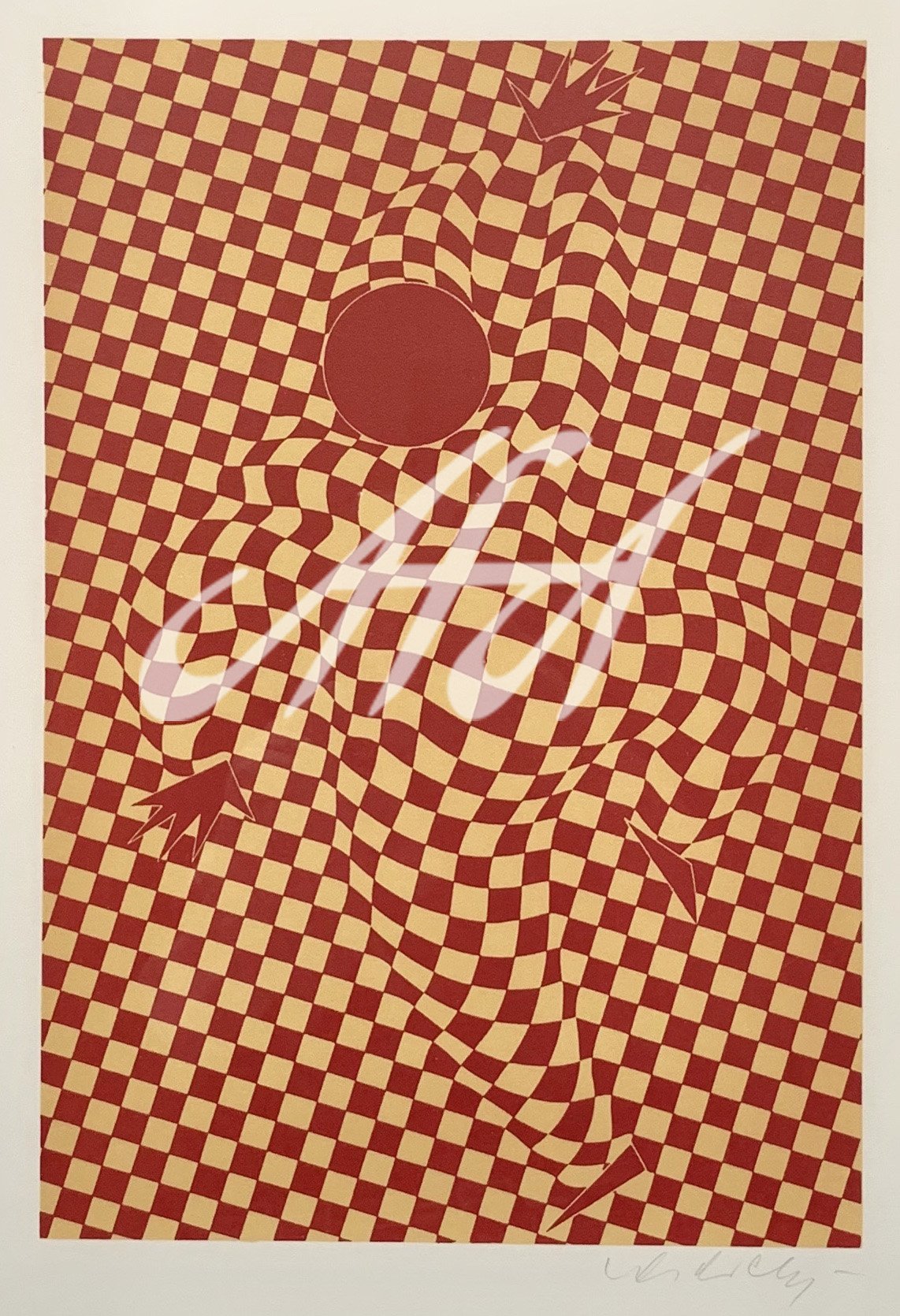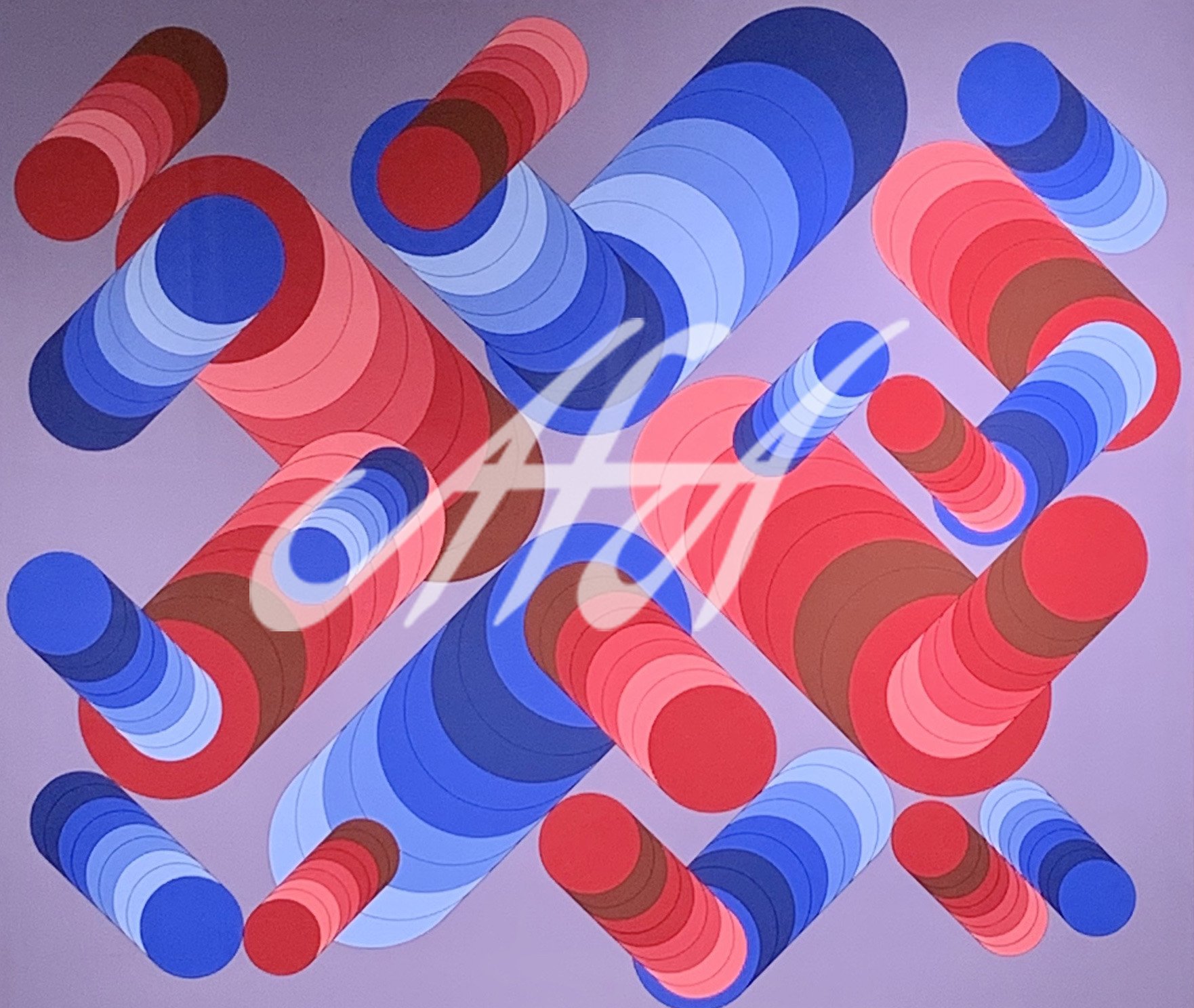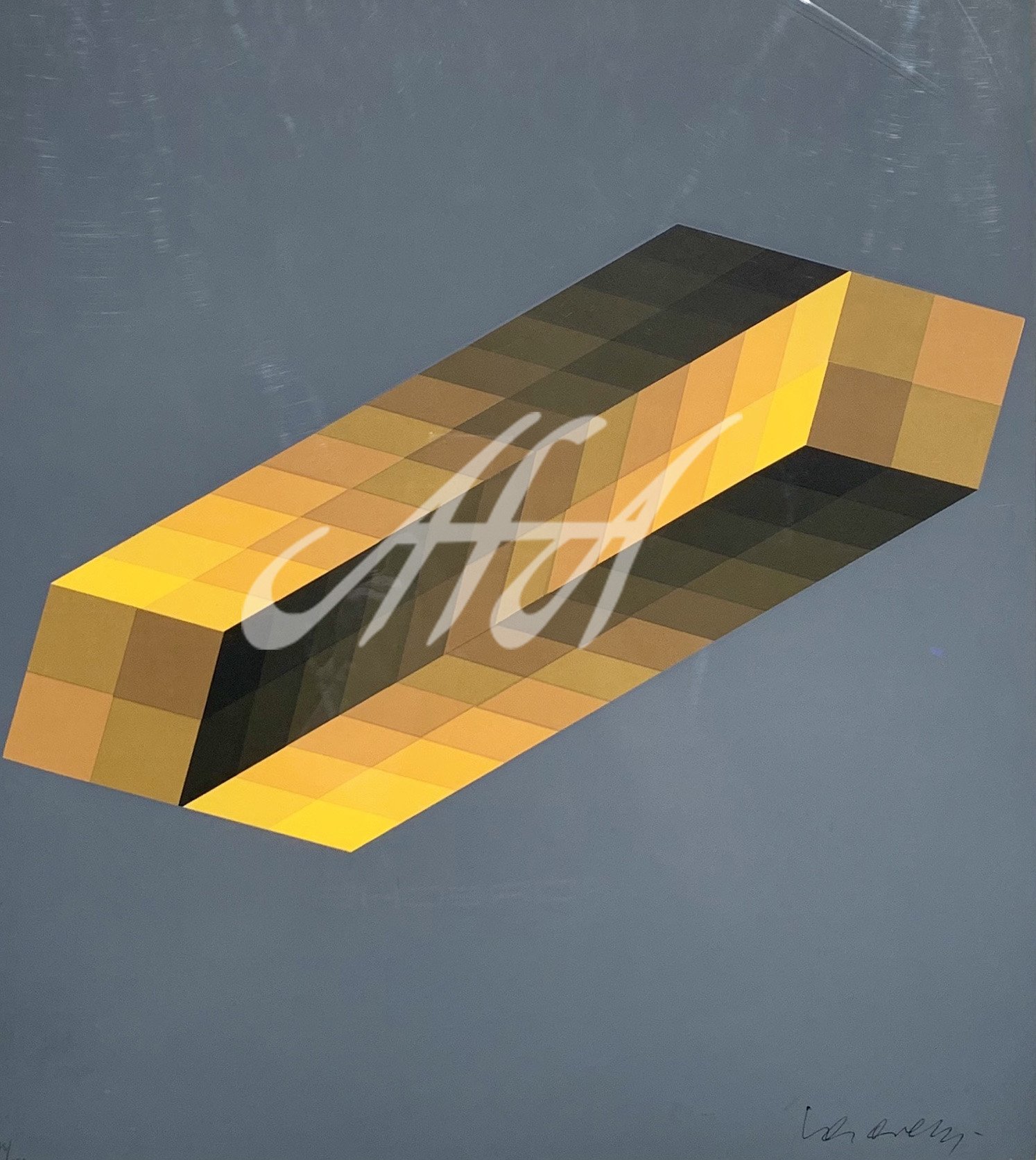Victor Vasarely
(Hungarian, 1908-1997)
“The art of tomorrow will be a collective treasure, or it will not be art at all.”
—Victor Vasarely
A celebrated artist during his own lifetime and after, Victor Vasarely separated himself from contemporary art by creating and leading the Optical Art movement of the 1960s. He was fascinated with linear patterning and used disorienting effects in images that explore the relay of sensory information in human perception. His Op Art works were an important part of modern art and the journey to abstraction, and are distinguishable by their hypnotizing colors, distorted surfaces, and repetition of geometric form. Vasarely’s Zebra (1937) is often considered one of the earliest examples of Op Art. Some of his best-known works are Vega (1957), The Plastic Alphabet (1960-65), and Gestalt (1969).
His birth name was Győző Vásárhelyi, born in Pécs, Hungary on April 9, 1908. He grew up in Slovakia and Budapest, working as a young man for a ball-bearings company where he helped with the accounting and designed advertising posters. He attended medical school for two years at Eötvös Loránd University, but abruptly shifted gears in 1927, going instead to study traditional academic painting at the private Podolini-Volkmann Academy with Sandor Bortniky. After two years there he was unsatisfied with the limits of academic painting, and he enrolled in the Bauhaus Muhely Academy in 1929, widely recognized at the time as Budapest's center of Bauhaus studies, which trained artists to use foundational geometric forms such as the cube, rectangle and the circle, which deeply influenced the artist. During this period, he discovered the Abstract movement and was introduced to Constructivism. He also devised and supported theories that promote art as more collective and less individualistic, and which adapts to the changing modern world and to the world of industry. He had his first one-man show in 1930 at the Kovacs Akos Gallery in Budapest, then moved to Paris, and married fellow student Claire Spinner in the same year. They would have two sons, one of whom would also become a renowned and prolific artist, professionally known as Yvaral.
Vasarely evolved from practicing graphic art to riding the first wave of abstraction, and combining it with mathematical formulas, science, and cosmic structures, and promoting a groundbreaking new social art for all. From 1929-1946, Vasarely’s work was often graphic and figurative. He worked from 1930-1935 as a graphic designer, poster artist, and creative consultant first at the advertising agencies Havas and Draeger, and later at Devambez. He was combining patterns and organic images with each other and beginning to experiment with shadow and light, perspective and textural effects. He opened an atelier in the Paris suburb of Arcueil after WWII, and until 1947, the artist briefly experimented with Cubist, Futurist, Expressionistic, Symbolist, and Surrealist painting. He ultimately did not feel he was developing a unique style with them. He called this period Les Fausses Routes, or “The Wrong Ways”. These works were exhibited in two galleries during this time, and the catalogue placed Vasarely among the Surrealists. Feeling he had veered from his true path, for the next few years he focused on developing geometric abstract art, or Optical Art, truly discovering and defining his own style and developing, with others, an exciting abstract movement. He studied the visuals of empty and filled spaces on a flat surface and in a stereoscopic, or three-dimensional, view. Using shapes from nature and the world around him, the artist named his pieces after the geographical locations associated with their inspiration. Denfert refers to the works influenced by the white tiled walls of the Paris Denfert – Rochereau metro station. Pebbles and shells found in 1947 at the Breton coast at Belle Île inspired him to create the Belles-Isles works. The cubic houses in Gordes in Provence-Alpes-Côte d'Azur led him compose the group of works Gordes/Cristal.
During the 1950s, he wrote a series of manifestos on optical phenomena for artistic purposes, like kinetic plasticity, and the idea of the viewer as the one unique artist, as well as embracing Constructivist and Bauhaus developments, which would significantly influence many artists. His kinetic images began in 1951; he superimposed acrylic/glass panes to create a moving or changing impression depending on the position of the viewer. Kinetic art boomed and by the time the first major exhibition of kinetic art was held, called Le Mouvement, at the Galerie Denise Rene in 1955, with works by Vasarely, Calder, Duchamp, Soto, and Tinguely, among others, Vasarely was already an established and celebrated avant-garde artist. Serial art and permutations were largely his focus from 1955 to ’65. At the height of his popularity, he created his some of most impactful works - the series he called The Plastic Alphabet, using 15 forms that were variations of the circle, triangle, and square, each of which had 20 different colors. Always depicted in a square frame, the plastic alphabet was repeatedly rearranged, creating an interesting and extensive series. Elements could be coded or programmed, and new techniques and technologies were used to arrange new works endlessly. Since standardized tools and impersonal assistants produced it, it raised the idea that the creative act could be conducted through a purely scientific process. It can be seen as both dehumanizing in that sense, and simultaneously, humanizing as it allowed anyone to participate in the creative aesthetic activity. Though his medical education hardly seems important for his ultimate career in art, it gave him a strong basis in scientific method and objectivity, which distinctly manifested in his unique style of art. In 1965, his work was part of The Responsive Eye, an exhibition at the Museum of Modern Art. He presented at Burtin’s Vision ’67 conference held at New York University.
A truly astounding, monumental project and achievement, the artist decided to build the Vasarely Foundation, his architectural center, in the city of Aix-en-Provence. The building had to be ultra-modern, and Vasarely designed it himself. Constructed between 1973 and 1976, its architecture adheres to no specific movement, although the ‘70s style is visible in both the materials, glass & anodized aluminum, and in the idea of bringing together architecture and technological design. As a “Lumino-kinetic” monumental sculpture, it is a remarkable example of the synthesis between architecture and plastic art. The artist and the architect Jean Sonnier opted for a system of 16 hexagon-shaped cells. With 5,000 sq. meters of floor space, a remarkable amount of skylight shines through the building’s fourteen pyramidal cupolas. The design of the exterior resembles, a creased curtain-like wall alternating monumental black and white circles and squares. The animation of the facade and its optical illusions prepare the visitor for the kinetic and optical tricks that they will discover once they enter the building. On the ground floor, seven “cells”, each 11 meters high, would host Vasarely’s 42 architectonic installations. Installations which measured up to eight meters high and six meters wide were set up in such a way as to allow the visitor to progress through the discovery of colors, materials, optical illusions and kinetic effects which stimulate participation but also disrupt and lose the visitor physically, in a space overwhelmed with color and uncertain limits. The rest of the building included a conference room/auditorium, a library, and storage rooms. Upstairs, there were offices and workshops for conducting new research or designing new installations. The Foundation is still doing tours and is run by Vasarely’s grandson, Pierre Vasarely.
In the 1970s and ‘80s, two other museums dedicated to his work were opened, although they are in disrepair or closed now. Another interesting item from the artist’s life is that his Space collage was taken into space on the Soyuz T-6 spacecraft and was brought onto Salyut 7, the French-Soviet space station in 1982, and later sold for the benefit of UNESCO. Vasarely passed away at age 90, in Paris on March 15, 1997.
Today Vasarely’s paintings, prints, collage, and sculptures are exhibited worldwide. A new Vasarely exhibit went up in Paris at the Musée en Herbe in 2012, and in 2019, a temporary exhibition of Vasarely's work was displayed in the Centre Georges Pompidou in Paris. Op Art was an enormously popular form of abstraction with much of its popularity due to the energetic, slick patterns and spatial tricks that Vasarely devised, and to the prints and posters he produced in profusion. While Vasarely was most prominence during the 1960s and his work has gone in and out of fashion since, his reputation is on the upswing today. His work and influence have been visible on the show Mad Men and in Gaspar Noé‘s Enter the Void. There have been several innovative and high-quality monographs dedicated to his work. The artist had several notable achievements, including receiving the Guggenheim Prize in 1964, the French Chevalier de L'Ordre de la Légion d'Honneur in 1970, the Art Critics Prize in Brussels, and the Gold Medal at the Milan Triennial.
American Fine Art, Inc. is proud to feature the original works and limited editions of Victor Vasarely. Visit our 12,000 sq. ft. showroom in Scottsdale, Arizona or call today. Our website is offered only as a limited place to browse or refresh your memory and is not a reflection of our current inventory. To learn more about collecting, pricing, value, or any other art information, please contact one of our International Art Consultants. We look forward to giving you the one on one attention you deserve when building your fine art collection. We hope you find our website helpful and look forward to seeing you in Scottsdale soon.

























